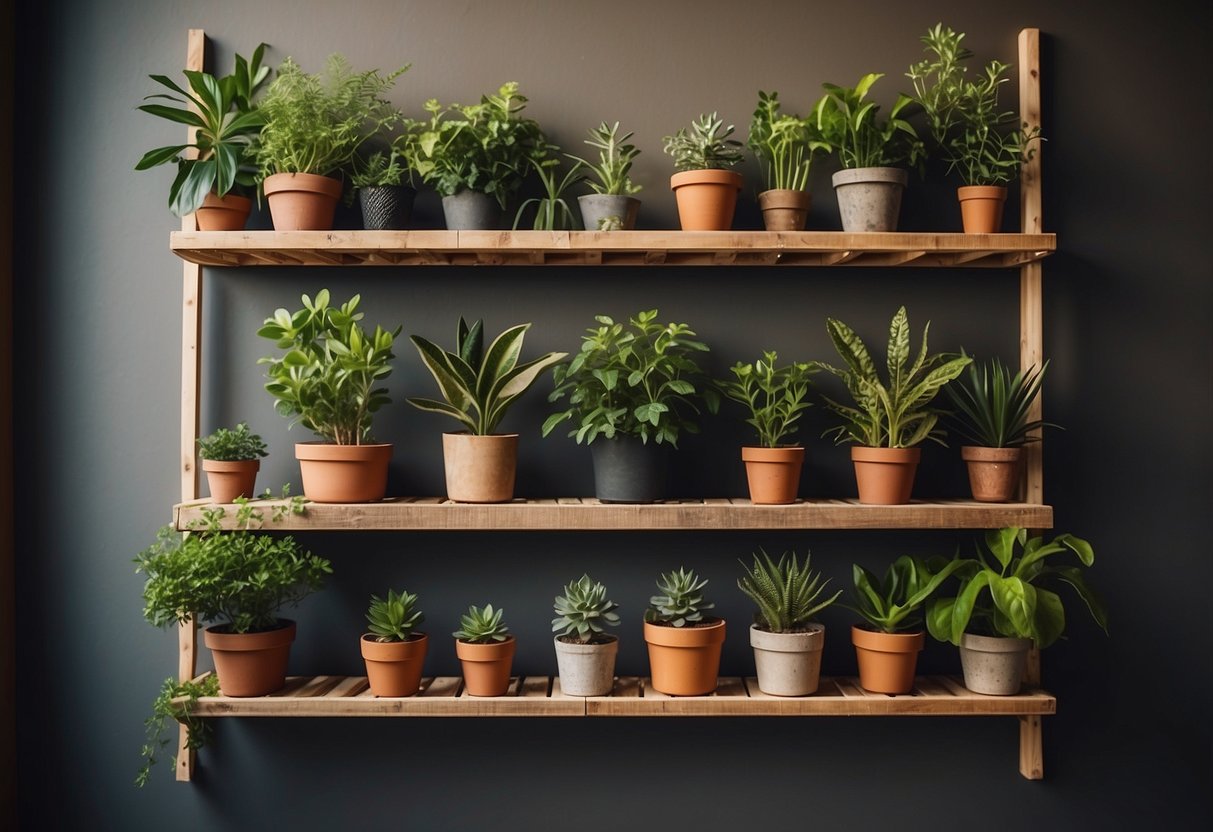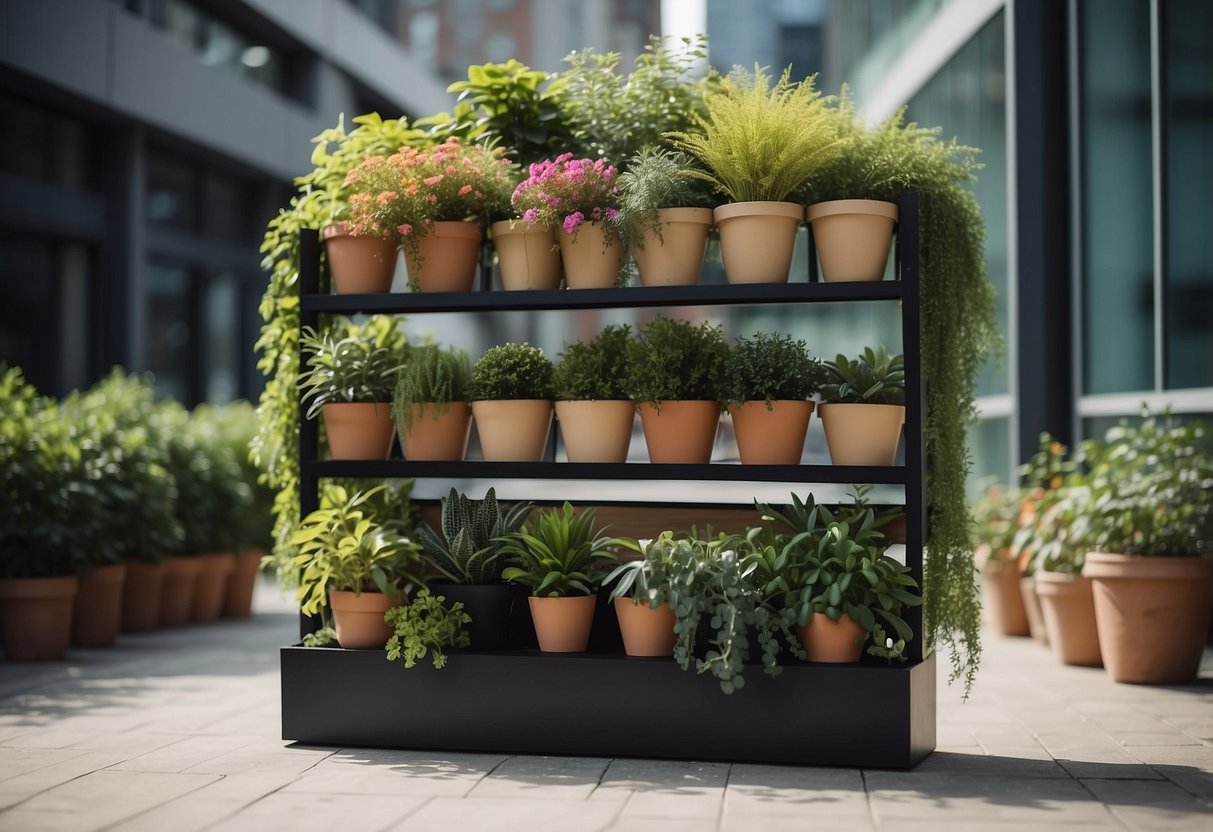Vertical DIY Garden Ideas: Create Space-Saving Greenery
Are you looking to make the most of your limited garden space? Vertical gardening is a fantastic way to maximize your area while adding a beautiful, unique touch to your home. It’s perfect for both indoor spaces like balconies and outdoor areas like patios.

Vertical garden ideas can transform small spaces into lush, green environments. You can use various materials and creative designs to build your own vertical garden, adding a refreshing vibe to your home. Get inspired and enjoy the process of creating your own green oasis.
1) Pallet Planter Wall

Using wooden pallets to create a planter wall is a fun and practical idea for vertical gardening. It’s a great way to save space and make your garden look fantastic.
Start by choosing a sturdy pallet. Clean it well and decide if you want to paint or stain it for a more polished look.
Next, fill the spaces between the slats with a high-quality potting mix. You can mix in some compost for added nutrients. Choose plants that suit the light conditions of your garden space, and enjoy your beautiful vertical garden!
For more details, you can visit these DIY vertical garden ideas.
2) Hanging Herb Garden

A hanging herb garden is a fantastic way to save space and add a touch of greenery to your home. You can use simple items like terra-cotta pots, wooden shelves, or even old pallets to create this garden.
Start by drilling holes in the containers for proper drainage. Then, secure them with sturdy ropes or zip ties. For a rustic look, use a pallet wood design or a reclaimed ladder.
This DIY project not only looks charming but also makes it easy to access your favorite herbs right in your kitchen or patio.
3) Vertical Terracotta Pot Tower

Creating a Vertical Terracotta Pot Tower is a fun and easy project. You only need five terracotta pots in different sizes, from large to small.
Start by placing the largest pot at the bottom. Fill it with soil, then insert a metal or wooden rod into the center. Stack the next smaller pot on top and repeat until all pots are stacked.
This tower is perfect for planting herbs or flowers. Place it in a sunny spot in your garden or patio. It also works well indoors near a bright window.
4) Gutter Garden

A gutter garden is a fantastic way to grow plants in small spaces. You can use old rain gutters to create a vertical garden on your fence or wall.
Gutter gardens are great for growing herbs and leafy greens. They are easy to make and maintain.
You can find some great ideas for gutter gardens at Balcony Garden Web.
5) Picture Frame Succulent Garden

A picture frame succulent garden is an easy and fun project. You’ll need an old picture frame, some hardware cloth, and succulents.
First, remove the glass and back of the frame. Attach the hardware cloth to the back. Fill the frame with soil, pushing it through the wire mesh.
Next, plant your succulents in the soil. Let them settle for a few days.
Hang your new vertical garden on a wall. It looks great indoors or outdoors. For more details, check out this guide.
6) Wooden Ladder Vertical Garden

A wooden ladder vertical garden is a charming and space-saving way to grow plants.
Using an old, worn-out ladder, you can create multiple tiers for your plants.
Place wooden planks across the rungs to form shelves.
This setup works well for herbs, flowers, and small vegetables.
Add a fresh coat of paint to match your garden’s decor for extra flair.
Learn more about creating a beautiful ladder planter vertical garden.
7) PVC Pipe Strawberry Planter

A PVC pipe strawberry planter is a fun and space-saving project.
To start, get a PVC pipe with a diameter of at least 10 inches. Cut the pipe to an appropriate height, keeping in mind that taller pipes may need reinforcement.
Drill holes for the strawberry plants, then fill the pipe with soil. Place plants in the holes.
This setup ensures good airflow and easy access to your strawberries. Enjoy your fresh fruit!
For more details, check out this guide on building a PVC strawberry tower.
8) Pocket Shoe Organizer Garden

Repurpose an old pocket shoe organizer to create a simple vertical herb garden. This method saves space and can add greenery to small areas like patios or balconies.
First, choose a location that gets enough sunlight. Hanging the organizer on a fence, garage, or shed works well.
Fill each pocket with soil and plant your herbs, such as basil, mint, or parsley. Water regularly to keep the plants healthy.
Check out more vertical garden ideas for inspiration.
9) Vertical Wine Rack Planter

Repurposing an old wine rack into a vertical planter is a fantastic idea. This creative solution turns something meant for bottles into a unique garden piece.
Paint the wine rack to match your outdoor decor. Then, fill each slot with a small pot or container of your favorite plants.
This method saves space and looks charming on patios or balconies. Plus, it’s an easy DIY project that can be completed in an afternoon. Try planting herbs for a convenient kitchen garden.
10) Freestanding Vertical Garden Stand

A freestanding vertical garden stand is perfect for small spaces.
Place it on your patio, balcony, or even inside your home.
You can use materials like wood or metal to build it.
Add planters or pots at different levels for a layered look.
This setup is great for herbs, flowers, or small vegetables.
It’s also easy to move if needed.
Benefits of Vertical DIY Gardens

Vertical DIY gardens bring multiple benefits to your living space. They help maximize limited areas, enhance the look of your surroundings, and even contribute to cleaner air.
Space Efficiency
One of the main advantages of vertical gardening is saving space. When you grow plants vertically, you use walls, fences, or other upright structures. This method is perfect for small patios, balconies, or urban homes.
By stacking plants upward, you can fit more greenery into tight areas. This approach also makes maintenance easier, as plants are at eye level or within easy reach. Vertical gardens are suitable for growing a variety of plants, including herbs, flowers, and even vegetables.
Vertical gardens also leave more ground space free for other uses. You can still enjoy outdoor furniture, a grill, or a play area without sacrificing your love for plants. It is a smart way to bring nature into your home without creating clutter.
Enhanced Aesthetics
Vertical gardens can make any space look more appealing. The sight of lush, cascading greenery instantly adds life and beauty to your walls or fences. You can mix and match different plants to create eye-catching designs and patterns.
Using colorful flowers or trailing vines can turn an ordinary wall into a focal point. You can also choose plants based on the season to keep your garden looking fresh all year. For a more dramatic effect, consider using planters or shelves to add depth and variety.
Matching your vertical garden with the style of your home or outdoor decor can enhance the overall aesthetic. Whether you prefer a modern, rustic, or eclectic look, there are countless ways to customize your garden. Vertical gardens add personality and a touch of artistry to your space.
Improved Air Quality
Vertical gardens can contribute to better air quality in and around your home. Plants naturally filter the air by absorbing carbon dioxide and releasing oxygen. They can also trap dust, allergens, and other pollutants, making the air cleaner to breathe.
Specific plants like ferns, spider plants, and peace lilies are known for their air-purifying properties. Including these plants in your vertical garden can help create a healthier living environment. The increased oxygen levels can also boost your mood and energy levels.
Moreover, vertical gardens can help cool down your living space. Plants naturally cool the air through the process of transpiration. When you place them on walls or fences, they can provide a layer of insulation, reducing the need for air conditioning in hot weather.
Planning Your Vertical Garden

Planning your vertical garden involves thinking about where to place it, what plants to choose, and what tools and materials you will need. This ensures a thriving garden and makes the process smoother.
Choosing the Right Location
The first step is to find the best spot for your vertical garden. Look for a place that gets plenty of sunlight, ideally 6-8 hours a day. Sunlight is crucial for most plants to grow well.
Make sure the area is accessible for watering and maintenance. If you are placing it on a wall or fence, ensure it can support the weight of the garden. Choosing a spot sheltered from strong winds can also protect your plants.
Lastly, consider how the location fits into your overall outdoor space. Make sure it is visually pleasing and practical. A good location is key to a successful vertical garden.
Selecting Suitable Plants
Choosing the right plants is essential for your vertical garden. Start by considering the climate and conditions of your chosen location. Some plants need more sunlight, while others can thrive in partial shade.
Vegetables like lettuce, herbs, and strawberries are great for beginners. They grow well in vertical setups and provide fresh produce. If you prefer flowers, look for varieties that grow vertically, like climbing roses or morning glories.
Pay attention to the growth habits of the plants. Trailing plants like ivy can cover large areas, while compact plants like succulents are ideal for smaller spaces. Mix and match different types to create a visually appealing and functional garden.
Essential Tools and Materials
Gathering the right tools and materials makes building your vertical garden much easier. Some basic tools you might need include a hammer, nails, screws, and a sturdy drill. These help in constructing the frame if you are building it yourself.
You will also need planters or pots suitable for vertical gardening. Options range from wooden pallets to plastic bottles or even old gutters. Make sure they have good drainage to prevent overwatering.
Soil, fertilizer, and watering tools like a hose or watering can are also essential. High-quality potting mix and regular feeding will keep your plants healthy. These tools and materials are vital for the success of your vertical garden.







